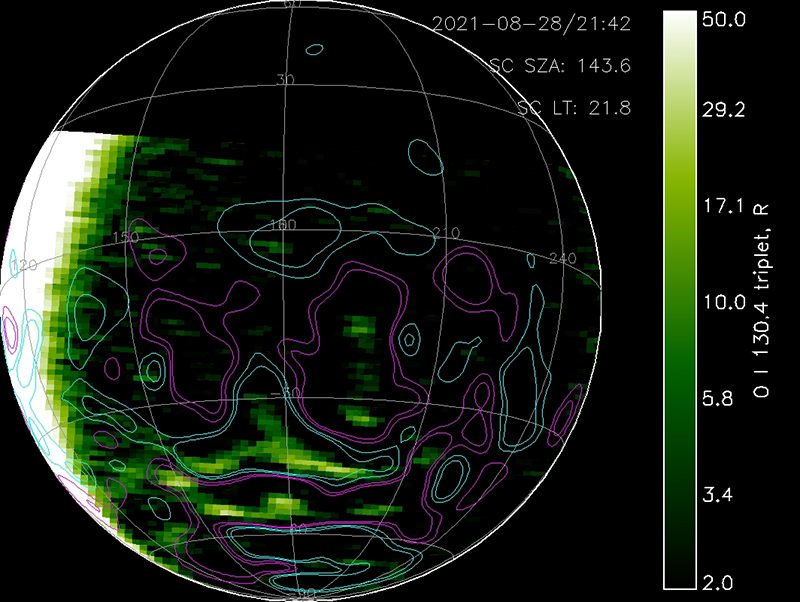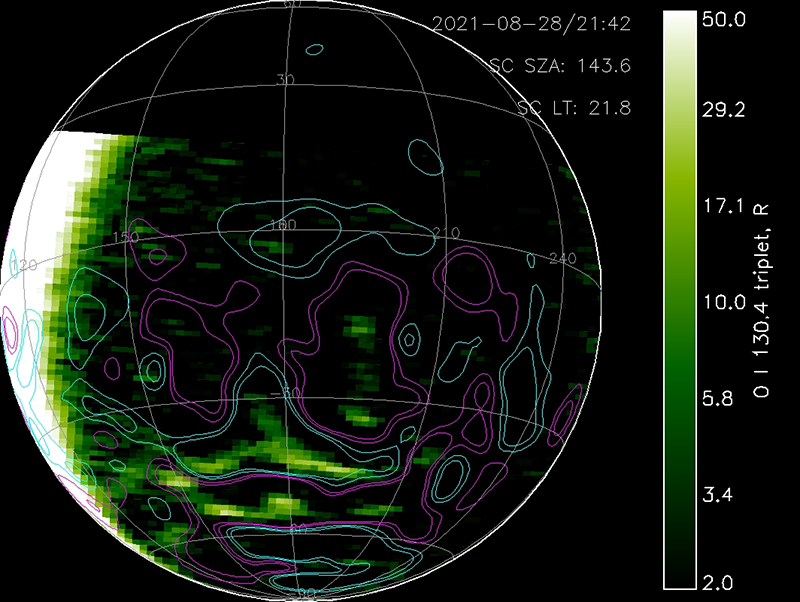Explaining Mars’ Patchy Aurora
The aurora borealis tops the list of natural wonders of our world. Similar night-sky displays on Mars are enigmatic wonders, as they originate on a smaller world that no longer generates a global magnetic field. Ben Johnston at the University of Colorado Boulder and colleagues now identify the specific physical processes that explain the origin of this unique type of aurora that occurs predominantly in the southern hemisphere on Mars [1, 2]. He and his team report spacecraft-based observations that reveal local and interplanetary magnetic-field interactions that activate our neighbor’s “southern lights.”
The processes responsible for an aurora depend on planetary features including magnetic-field geometry and atmospheric density and composition. The auroras on Earth, Jupiter, and Saturn are linked to global dipolar magnetic fields generated by convective-based dynamos within each planet’s interior. Early Mars is thought to have had a similar planet-wide magnetic field, but evidence suggests that this field turned off 4 billion years ago. And yet, there are vestiges of this ancient magnetic field in regions of the planet’s crust. “Lava flows that cooled in the presence of the ancient magnetic field record it in their minerals, just like on Earth’s seafloor,” explains team member Nick Schneider from the University of Colorado Boulder.
It was above these magnetized regions that the first evidence of Martian auroras was detected 15 years ago. Using spectroscopic instruments on ESA’s Mars Express spacecraft, researchers spotted patchy, short-lasting UV emissions on Mars’ nightside, most often in the planet’s southern hemisphere. Since then, researchers have hypothesized about what causes these so-called discrete auroras.
“We suspected that discrete auroras are ultimately the result of the interplay between the magnetic field within the solar wind and the crustal magnetic fields of Mars,” says team member Charlie Bowers, now at the Dublin Institute for Advanced Studies. However, the specific physical processes responsible for discrete auroras were yet to be understood.
Recently, instruments onboard NASA’s Mars Atmosphere and Volatile Evolution (MAVEN) orbiter returned 49 spectrograph images of localized discrete auroras lighting up in different places at different times. By comparing these images to magnetometer data from MAVEN, Schneider, Bowers, and their colleagues have found a pattern. The researchers observed that the discrete auroras occur most distinctly in two adjacent regions on the surface. Importantly, these regions have opposite polarity: the magnetic-field lines of one point north, while that of the other point south. As a result, the two regions interact differently with the interplanetary-magnetic-field (IMF) lines traced by the solar wind. The IMF lines can point in a variety of orientations, but the team showed that the auroral activity occurred predominantly when the IMF lines were antiparallel to the crustal lines of one of the regions. This alignment occurred at different times of night—just after dusk and just before dawn—for the two magnetic regions.
The correlation between the auroras and the antiparallel field lines led the team to the culprit: a process known as magnetic reconnection. Put simply, it’s the tendency of antiparallel magnetic-field lines to rearrange themselves into a different order, releasing energy in the process. During reconnection, field lines that are typically looped back on themselves are wide open. This opening provides a pathway for solar wind particles (in particular, electrons) to accelerate from above the atmosphere down toward the planet. These electrons hit gas molecules in Mars’ atmosphere and excite them, resulting in aurora displays. “Auroras are a particularly beautiful phenomena because they are the visual finale to a number of fascinating physical processes, beginning in the Sun and ending in a planetary atmosphere,” Bowers says.
The new work provides the clearest evidence yet that magnetic reconnection causes the Martian auroras.“By choosing the simplest region of Mars’ complicated crustal fields, we were able to isolate the unique signature of reconnection in the timing of aurora events,” Schneider says. The study provides a framework for understanding unexplained trends in how auroras are activated on Mars and other planetary bodies in our Solar System and beyond. Further, the UV emission should be accompanied by bright, visible emissions that, Schneider hopes, will one day be captured on video by a rover, an orbiter, or a future astronaut.
Dimitra Atri, who leads the Mars Research Group at New York University Abu Dhabi, says “this is the first study where observations strongly support the magnetic-reconnection hypothesis, providing clarity on discrete auroras in this region.” But broader-spanning auroras in other regions of Mars remain an “intriguing mystery.” Better understanding of the solar wind interactions with Mars’ magnetosphere and atmosphere will, he hopes, shed light on how the planet “lost a significant portion of its atmosphere due to space weather activity and how it evolved from being a potentially habitable planet to a cold and dry desert that we see today.”
–Rachel Berkowitz
Rachel Berkowitz is a Corresponding Editor for Physics Magazine based in Vancouver, Canada.
References
- C. F. Bowers et al., “Evidence for magnetic reconnection as the precursor to discrete aurora at Mars,” J. Geophys. Res.: Space Phys. 128 (2023).
- B. J. Johnston et al., “Discrete aurora at Mars: Insights into the role of magnetic reconnection,” Geophys. Res. Lett. 50 (2023).





